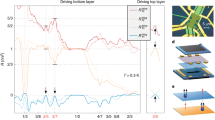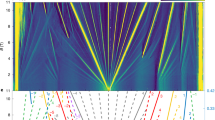Abstract
Heterostructures of vertically stacked graphene double layers, separated by a thin tunnel barrier, provide a highly tunable system to explore strongly interacting electron states. This is because the interlayer Coulomb interactions can be sensitively tuned simply by varying the barrier thickness. Recent studies of double-layer graphene have shown that, in the quantum Hall effect regime, strong interlayer coupling can induce electron–hole pairing across the two layers, resulting in a superfluid phase of interlayer excitons1,2,3. Here, we report a series of emergent fractional quantum Hall effect (FQHE) states appearing under similar conditions. We find excellent agreement between the sequence of observable FQHE states and the theoretically proposed two-component composite-fermion (CF) model, where the CF quasiparticle construction results from both interlayer and intralayer interactions4,5. Most remarkably, we observe an additional series of incompressible states at fractional filling that do not fit within either the single- or two-component CF models. We interpret these states to result from residual pairing interactions between CFs, representing a new type of correlated ground state that is unique to graphene double-layer structures and not described by the conventional CF model.
This is a preview of subscription content, access via your institution
Access options
Access Nature and 54 other Nature Portfolio journals
Get Nature+, our best-value online-access subscription
$29.99 / 30 days
cancel any time
Subscribe to this journal
Receive 12 print issues and online access
$209.00 per year
only $17.42 per issue
Buy this article
- Purchase on Springer Link
- Instant access to full article PDF
Prices may be subject to local taxes which are calculated during checkout



Similar content being viewed by others
Data availability
The data that support the plots within this paper and other findings of this study are available from the corresponding author on reasonable request.
References
Eisenstein, J. P. Exciton condensation in bilayer quantum Hall systems. Annu. Rev. Condens. Matter Phys. 5, 159–181 (2014).
Li, J. I. A., Taniguchi, T., Watanabe, K., Hone, J. & Dean, C. R. Excitonic superfluid phase in double bilayer graphene. Nat. Phys. 13, 751–755 (2017).
Liu, X., Taniguchi, T., Watanabe, K., Halperin, B. & Kim, P. Quantum Hall drag of exciton condensate in graphene. Nat. Phys. 13, 746–750 (2017).
Scarola, V. W. & Jain, J. K. Phase diagram of bilayer composite fermion states. Phys. Rev. B 64, 085313 (2001).
Jain, J. K. Composite Fermions (Cambridge University Press, 2003).
Tsui, D. C., Stormer, H. L. & Gossard, A. C. Two-dimensional magnetotransport in the extreme quantum limit. Phys. Rev. Lett. 48, 1559–1562 (1982).
Laughlin, R. B. Anomalous quantum Hall effect: an incompressible quantum fluid with fractionally charged excitations. Phys. Rev. Lett. 50, 1395–1398 (1983).
Kellogg, M., Eisenstein, J. P., Pfeiffer, L. N. & West, K. W. Vanishing Hall resistance at high magnetic field in a double-layer two-dimensional electron system. Phys. Rev. Lett. 93, 036801 (2004).
Tutuc, E., Shayegan, M. & Huse, D. A. Counterflow measurements in strongly correlated GaAs hole bilayers: evidence for electron–hole pairing. Phys. Rev. Lett. 93, 036802 (2004).
Nandi, D., Finck, A. D. K., Eisenstein, J. P., Pfeiffer, L. N. & West, K. W. Exciton condensation and perfect Coulomb drag. Nature 488, 481–484 (2012).
Halperin, B. I. Theory of the quantized Hall conductance. Helv. Phys. Acta 56, 75–102 (1983).
Suen, Y. W., Engel, L. W., Santos, M. B., Shayegan, M. & Tsui, D. C. Observation of a ν = 1/2 fractional quantum Hall state in a double-layer electron system. Phys. Rev. Lett. 68, 1379–1382 (1992).
Eisenstein, J. P., Boebinger, G. S., Pfeiffer, L. N., West, K. W. & He, S. New fractional quantum Hall state in double-layer two-dimensional electron systems. Phys. Rev. Lett. 68, 1383–1386 (1992).
Suen, Y., Manoharan, H., Ying, X., Santos, M. & Shayegan, M. Origin of the ν = 1/2 fractional quantum Hall state in wide single quantum wells. Phys. Rev. Lett. 72, 3405 (1994).
Shabani, J. et al. Phase diagrams for the stability of the \(\nu = \frac{1}{2}\) fractional quantum Hall effect in electron systems confined to symmetric, wide GaAs quantum wells. Phys. Rev. B 88, 245413 (2013).
Wen, X.-G. & Zee, A. Neutral superfluid modes and ‘magnetic’ monopoles in multilayered quantum Hall systems. Phys. Rev. Lett. 69, 1811–1814 (1992).
Alicea, J., Motrunich, O. I., Refael, G. & Fisher, M. P. A. Interlayer coherent composite Fermi liquid phase in quantum Hall bilayers. Phys. Rev. Lett. 103, 256403 (2009).
Ardonne, E., Lankvelt, F. J. Mv, Ludwig, A. W. W. & Schoutens, K. Separation of spin and charge in paired spin-singlet quantum Hall states. Phys. Rev. B 65, 041305 (2002).
Barkeshli, M. & Wen, X.-G. Non-Abelian two-component fractional quantum Hall states. Phys. Rev. B 82, 233301 (2010).
Geraedts, S., Zaletel, M. P., Papić, Z. & Mong, R. S. K. Competing Abelian and non-Abelian topological orders in ν = 1/3 + 1/3 quantum Hall bilayers. Phys. Rev. B 91, 205139 (2015).
Liu, Z., Vaezi, A., Lee, K. & Kim, E.-A. Non-Abelian phases in two-component ν = 2/3 fractional quantum Hall states: emergence of Fibonacci anyons. Phys. Rev. B 92, 081102 (2015).
Britnell, L. et al. Electron tunneling through ultrathin boron nitride crystalline barriers. Nano Lett. 12, 1707–1710 (2012).
Gorbachev, R. V. et al. Strong Coulomb drag and broken symmetry in double-layer graphene. Nat. Phys. 9, 775–779 (2013).
Li, J. I. A. et al. Negative Coulomb drag in double bilayer graphene. Phys. Rev. Lett. 117, 046802 (2016).
Lee, K. et al. Giant frictional drag in double bilayer graphene heterostructures. Phys. Rev. Lett. 117, 046803 (2016).
Zeng, Y. et al. High-quality magnetotransport in graphene using the edge-free Corbino geometry. Phys. Rev. Lett. 122, 137701 (2019).
Halperin, B. I., Lee, P. A. & Read, N. Theory of the half-filled Landau level. Phys. Rev. B 47, 7312–7343 (1993).
Pan, W. et al. Fractional quantum Hall effect of composite fermions. Phys. Rev. Lett. 90, 016801 (2003).
Mukherjee, S., Mandal, S. S., Wójs, A. & Jain, J. K. Possible anti-Pfaffian pairing of composite fermions at ν = 3/8. Phys. Rev. Lett. 109, 256801 (2012).
Mukherjee, S., Jain, J. K. & Mandal, S. S. Possible realization of a chiral p-wave paired state in a two-component system. Phys. Rev. B 90, 121305 (2014).
Kamilla, R. K., Wu, X. G. & Jain, J. K. Excitons of composite fermions. Phys. Rev. B 54, 4873–4884 (1996).
Renn, S. R. Edge excitations and the fractional quantum Hall effect in double quantum wells. Phys. Rev. Lett. 68, 658–661 (1992).
Acknowledgements
This work was supported by the National Science Foundation (DMR-1507788) and by the David and Lucille Packard Foundation. Data analysis was partially supported by the US Department of Energy (DE-SC0016703). A portion of this work was performed at the National High Magnetic Field Laboratory, which is supported by National Science Foundation Cooperative Agreement No. DMR-1157490 and the State of Florida.
Author information
Authors and Affiliations
Contributions
J.I.A.L. and C.R.D. designed the experiment. Experimental work and analysis was carried out by J.I.A.L., Q.S. and Y.Z., advised by J.H. and C.R.D. All authors contributed to writing the manuscript.
Corresponding author
Ethics declarations
Competing interests
The authors declare no competing interests.
Additional information
Peer review information: Nature Physics thanks G. J. Sreejith, Emanuel Tutuc and the other, anonymous, reviewer(s) for their contribution to the peer review of this work.
Publisher’s note: Springer Nature remains neutral with regard to jurisdictional claims in published maps and institutional affiliations.
Supplementary information
Supplementary Information
Supplementary Figs. 1–6, Supplementary Refs. 1–3 and additional experimental and theoretical details.
Rights and permissions
About this article
Cite this article
Li, J.I.A., Shi, Q., Zeng, Y. et al. Pairing states of composite fermions in double-layer graphene. Nat. Phys. 15, 898–903 (2019). https://doi.org/10.1038/s41567-019-0547-z
Received:
Accepted:
Published:
Issue Date:
DOI: https://doi.org/10.1038/s41567-019-0547-z
This article is cited by
-
Signature of quantum interference effect in inter-layer Coulomb drag in graphene-based electronic double-layer systems
Nature Communications (2023)
-
Beryllene, the lightest Xene
npj 2D Materials and Applications (2023)
-
Size dependence- and induced transformations- of fractional quantum Hall effects under tilted magnetic fields
Scientific Reports (2022)
-
Strain-induced quantum Hall phenomena of excitons in graphene
Scientific Reports (2022)
-
Bilayer WSe2 as a natural platform for interlayer exciton condensates in the strong coupling limit
Nature Nanotechnology (2022)



